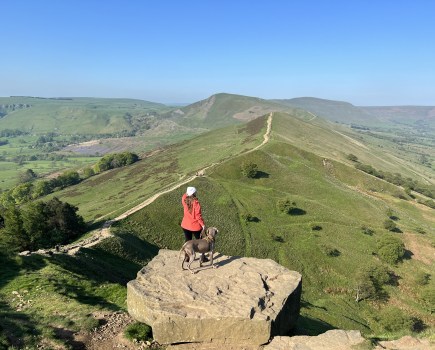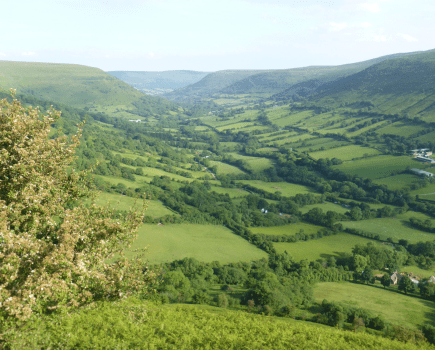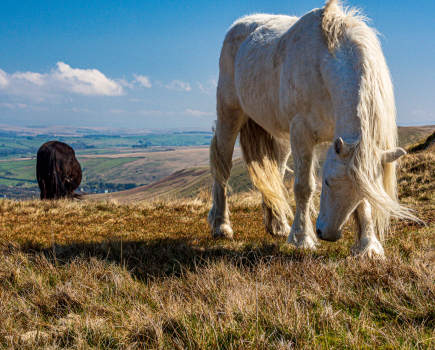Roger Butler explores the Gower Peninsula, Britain’s first Area of Outstanding Natural Beauty
The Gower Peninsula packs an extraordinary mix of scenery into a relatively small area and it is not surprising that, way back in 1956, it was declared Britain’s very first Area of Outstanding Natural Beauty. The limestone cliffs running along its southern coast are justly famous, but a patchwork of open commons, heathery moors, fertile salt marsh and tall sand dunes ensure excellent wild walking.
We followed field paths from Pilton Green towards the tall cliffs which guard the east side of Mewslade Bay, where the smell of beach barbecues drifted up from secluded hidden coves. At the far end of a crumbling path a heap of brightly coloured kayaks pointed the way up to a broad coastal plateau running south from Rhossili village. The distinctive strip fields were established here in medieval times and remain in use today.
Worm’s Head swung into view, hunched as if to pounce on a pod of whales or even a passing container ship, and definitely bearing a resemblance to some sort of mystical sea serpent. Thousands of islands are dotted around our shores, but surely none have such an striking and unmistakeable profile. The jagged tidal causeway, gateway to a memorable romp over a natural rock arch called the Devil’s Bridge, was custom made for children’s adventure stories. Such tales might describe how someone was stranded and forced to spend the night on what the locals simply call The Worm.
A volunteer coastguard told me that new foreign tourists are increasingly being caught out by the fast rising waters and one reason seems to be that many grew up in landlocked countries with no knowledge of the sea or the tides. Local boy Dylan Thomas was once marooned here though, and maybe he passed the time listening to the grey seals whose haunting calls echoed from the rocks on the north side of the island.
Matchstick children splashed in the waves on Rhossili’s majestic beach, but we climbed onto the broad whaleback rising above the village. Rhossili Down is an airy and elevated ridge that forms a solid bookend to the west end of Gower with fine views in every direction. The long promontory of Whiteford Burrows stretched north towards a silent estuary and old cast iron lighthouse.
By the end of the afternoon we were lost in a maze of dunes out at the very far end of the lonely Burrows. Rare orchids and tall viper’s bugloss grew by the damp slacks, whilst sea lavender shimmered like a mirage on the far side of Berges Island. A couple of peregrines, probably nesting on the crags north of Cheriton, screeched overhead and a network of muddy creeks wriggled its way through an expansive salt marsh called The Groose.
Newly erected signs showed where the Welsh Coast Path continued along the unfrequented north coast. If we had kept walking it would only have been another 720 miles before we reached the English border by the River Dee. I looked across the Burry Inlet to distant Llanelli, now lost in the heat and the haze, and the thought of it made me both excited and very tired.
ROUTE DESCRIPTION
- From Pilton Green take path leading SW to Foxhole Slade on coast. Turn W to follow cliffs for approx 2km to Mewslade Bay. Drop down narrow valley to beach, take path rising W above cliffs for 1.3km. Climb up slope and continue W to coastguard hut – tide times for Worm’s Head are displayed here.
- If tide conditions suit, cross causeway, climb Inner Head, continue W over Devil’s Bridge – please obey any signs re: bird nesting season. Retrace route back to coastguard and walk NE into Rhossili village.
- Take track on L after church to climb Rhossili Down and continue due N on paths to Llangennith. Cross road, take lane N and walk NE over Llanmadoc Hill. Take track N into Llanmadoc and follow lane down to Cwm Ivy.
- Continue on narrow lane to edge of forestry, go through gate by cottage and follow tack for 900m to next gate. Turn L into dunes, walk N to beach and lighthouse.
- Walk SE through dunes to salt marsh, turn R and after 1.5km turn L onto dyke with paths leading up to Llanmadoc.
Roger Butler explores the Gower Peninsula, Britain’s first Area of Outstanding Natural Beauty
The Gower Peninsula packs an extraordinary mix of scenery into a relatively small area and it is not surprising that, way back in 1956, it was declared Britain’s very first Area of Outstanding Natural Beauty. The limestone cliffs running along its southern coast are justly famous, but a patchwork of open commons, heathery moors, fertile salt marsh and tall sand dunes ensure excellent wild walking.
We followed field paths from Pilton Green towards the tall cliffs which guard the east side of Mewslade Bay, where the smell of beach barbecues drifted up from secluded hidden coves. At the far end of a crumbling path a heap of brightly coloured kayaks pointed the way up to a broad coastal plateau running south from Rhossili village. The distinctive strip fields were established here in medieval times and remain in use today.
Worm’s Head swung into view, hunched as if to pounce on a pod of whales or even a passing container ship, and definitely bearing a resemblance to some sort of mystical sea serpent. Thousands of islands are dotted around our shores, but surely none have such an striking and unmistakeable profile. The jagged tidal causeway, gateway to a memorable romp over a natural rock arch called the Devil’s Bridge, was custom made for children’s adventure stories. Such tales might describe how someone was stranded and forced to spend the night on what the locals simply call The Worm.
A volunteer coastguard told me that new foreign tourists are increasingly being caught out by the fast rising waters and one reason seems to be that many grew up in landlocked countries with no knowledge of the sea or the tides. Local boy Dylan Thomas was once marooned here though, and maybe he passed the time listening to the grey seals whose haunting calls echoed from the rocks on the north side of the island.
Matchstick children splashed in the waves on Rhossili’s majestic beach, but we climbed onto the broad whaleback rising above the village. Rhossili Down is an airy and elevated ridge that forms a solid bookend to the west end of Gower with fine views in every direction. The long promontory of Whiteford Burrows stretched north towards a silent estuary and old cast iron lighthouse.
By the end of the afternoon we were lost in a maze of dunes out at the very far end of the lonely Burrows. Rare orchids and tall viper’s bugloss grew by the damp slacks, whilst sea lavender shimmered like a mirage on the far side of Berges Island. A couple of peregrines, probably nesting on the crags north of Cheriton, screeched overhead and a network of muddy creeks wriggled its way through an expansive salt marsh called The Groose.
Newly erected signs showed where the Welsh Coast Path continued along the unfrequented north coast. If we had kept walking it would only have been another 720 miles before we reached the English border by the River Dee. I looked across the Burry Inlet to distant Llanelli, now lost in the heat and the haze, and the thought of it made me both excited and very tired.
ROUTE DESCRIPTION
- From Pilton Green take path leading SW to Foxhole Slade on coast. Turn W to follow cliffs for approx 2km to Mewslade Bay. Drop down narrow valley to beach, take path rising W above cliffs for 1.3km. Climb up slope and continue W to coastguard hut – tide times for Worm’s Head are displayed here.
- If tide conditions suit, cross causeway, climb Inner Head, continue W over Devil’s Bridge – please obey any signs re: bird nesting season. Retrace route back to coastguard and walk NE into Rhossili village.
- Take track on L after church to climb Rhossili Down and continue due N on paths to Llangennith. Cross road, take lane N and walk NE over Llanmadoc Hill. Take track N into Llanmadoc and follow lane down to Cwm Ivy.
- Continue on narrow lane to edge of forestry, go through gate by cottage and follow tack for 900m to next gate. Turn L into dunes, walk N to beach and lighthouse.
- Walk SE through dunes to salt marsh, turn R and after 1.5km turn L onto dyke with paths leading up to Llanmadoc.








